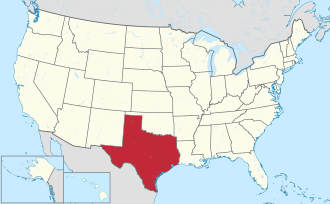Top Qs
Timeline
Chat
Perspective
Fannin County, Texas
County in Texas, United States From Wikipedia, the free encyclopedia
Remove ads
Fannin County is a county in the far northeast of the U.S. state of Texas, on the border with Oklahoma. As of the 2020 census, its population was 35,662,[1] making it the 87th-most populous county in Texas.[2] The entirety of Fannin County is a part of the Bonham micropolitan statistical area and the Dallas-Fort Worth combined statistical area. The county seat is Bonham.[3]
Remove ads
Remove ads
History

The county was named for James Fannin,[4] who commanded the group of Texans killed in the Goliad Massacre during the Texas Revolution. James Bonham (the county seat's namesake) sought Fannin's assistance for the Battle of the Alamo, but Fannin was unable to provide it.
The county was created in 1837 and organized the next year.[5][6] Fannin County is a part of the Texoma region.
Remove ads
Geography
According to the U.S. Census Bureau, the county has a total area of 899 square miles (2,330 km2), of which 8.0 square miles (21 km2) (0.9%) are covered by water.[7] It is drained by Bois D'Arc Creek and Sulphur River.[8]
Major highways
Adjacent counties
- Bryan County, Oklahoma (north)
- Lamar County (east)
- Delta County (southeast)
- Hunt County (south)
- Collin County (southwest)
- Grayson County (west)
National protected area
Remove ads
Demographics
Summarize
Perspective
As of the 2000 census,[16] 31,242 people, 11,105 households, and 7,984 families resided in the county. The population density was 35 people per square mile (14 people/km2). The 12,887 housing units averaged 14 units per square mile (5.4/km2). The racial makeup of the county was 86.56% White, 7.96% African American, 0.92% Native American, 0.26% Asian, 2.81% from other races, and 1.49% from two or more races. About 5.61% of the population was Hispanic or Latino of any race. As of 2015, the largest self-reported ancestry groups were 48.50% English, 16.10% Welsh, 11.00% German, and 7.25% Irish.
Of the 11,105 households, 31.1% had children under 18 living with them, 57.9% were married couples living together, 10.3% had a female householder with no husband present, and 28.1% were not families. About 25.2% of all households were made up of individuals, and 12.7% had someone living alone who was 65 or older. The average household size was 2.51, and the average family size was 2.99.
In the county, the population was distributed as 23.2% under 18, 8.9% from 18 to 24, 28.6% from 25 to 44, 23.2% from 45 to 64, and 16.1% who were 65 or older. The median age was 38 years. For every 100 females, there were 113.8 males. For every 100 females age 18 and over, there were 116.9 males.
The median income for a household in the county was $34,501, and for a family was $42,193. Males had a median income of $31,140 versus $23,101 for females. The per capita income for the county was $16,066. About 9.90% of families and 13.90% of the population were below the poverty line, including 17.70% of those under age 18 and 16.50% of those age 65 or over.
Remove ads
Communities
Cities
- Bailey
- Bonham (county seat)
- Ector
- Honey Grove
- Leonard
- Pecan Gap (mostly in Delta County)
- Ravenna
- Savoy
- Trenton (small part in Grayson County)
Towns
- Dodd City
- Ladonia
- Whitewright (mostly in Grayson County)[17]
- Windom
Unincorporated communities
Education
These independent school districts (ISDs) serve Fannin County:[18]
- Blue Ridge ISD (mostly in Collin County, small portion in Fannin County)
- Bonham ISD
- Dodd City ISD
- Ector ISD
- Fannindel ISD
- Honey Grove ISD
- Leonard ISD
- North Lamar ISD (mostly in Lamar County, small portion in Fannin County)
- Sam Rayburn ISD
- Savoy ISD
- Trenton ISD (mostly in Fannin County, small portion in Grayson County)
- Whitewright ISD (mostly in Grayson County, small portion in Fannin County)
- Wolfe City ISD (mostly in Hunt County, small portion in Fannin County)
Additionally, nearby Grayson College, Paris Junior College, and East Texas A&M University provide postsecondary education in the area.
As per the Texas Education Code, Grayson College's service area includes parts of the county in these ISDs: Bonham, Dodd City, Ector, Leonard, Sam Rayburn, Savoy, Trenton, Whitewright, and Wolfe City. The Fannindel ISD portion and the Honey Grove ISD portion are in the service area of Paris Junior College. The code does not specify a community college for the Blue Ridge ISD and North Lamar ISD areas.[19]
Remove ads
Politics
Once a Democratic stronghold for decades (in large part as it was the home of longtime United States Speaker of the House Sam Rayburn), Fannin County has shifted heavily toward the Republican Party since the 1990s. As a sign of this trend, Republican candidates for president have won an ever-increasing share of the vote in each of the seven presidential elections, starting in 1996.
Remove ads
See also
References
External links
Wikiwand - on
Seamless Wikipedia browsing. On steroids.
Remove ads



